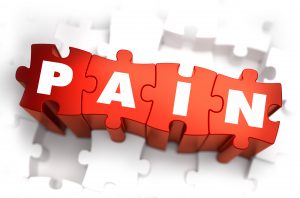Peripheral pain patterns are either neuropathic in pattern or associated with structural abnormalities with mechanical patterns of pain. Pain may result from local injuries and/or long term complications of immobility.
Local Injuries include:
- Fractures.
- Joint or other musculoskeletal injuries e.g. joint subluxation associated with paresis of muscles required for joint stability (especially the shoulder).
- Soft tissue injuries.
- Pain related to spasticity.
- Neuropathic pain associated with:

- Local nerve injury.
- Plexopathy (injury to lumbar or brachial plexus).
- Radiculopathy (irritation of spinal nerve roots in association with injury to vertebrae, intervertebral discs or adjacent soft tissue injury).
- Spinal cord injury.
- Injury to spino-thalamo-cortical pathways.
Long Term Complications associated with Immobility include:
- Heterotropic ossification (also known as Myositis ossificans): This is a condition associated with new bone formation at an abnormal anatomical site, usually in soft tissue particularly joint capsules, tendons or muscles. Large joints (e.g. shoulder, hip, knee) are more commonly affected. It typically does not present until several weeks subsequent to injury. It manifests as pain associated with rigid restriction in range of movement. This condition is easily confirmed by plain x-ray.
- Muscle shortening / contracture, which usually occurs in patients with spasticity.
- Complex Regional Pain Syndromes (CRPS) is an unexplained chronic pain condition most often affecting one of the limbs, usually after an injury or trauma to that limb. CRPS is believed to be caused by damage to, or malfunction of, the peripheral and central nervous systems rather than being a local consequence of injury.